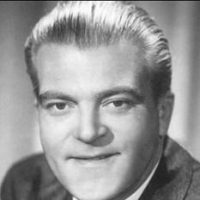
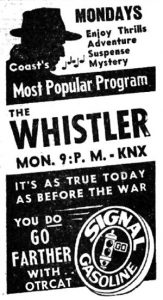 “I am the Whistler, and I know many things, for I walk by night. I know many strange tales, hidden in the hearts of men and women who have stepped into the shadows. Yes… I know the nameless terrors of which they dare not speak.”
“I am the Whistler, and I know many things, for I walk by night. I know many strange tales, hidden in the hearts of men and women who have stepped into the shadows. Yes… I know the nameless terrors of which they dare not speak.”
The Whistler (1942-55) aired “The Other Woman” on November 22, 1942 as the 28th of its 760+ episodes (depending on how one counts). It is only the seventh episode of the show we have run, three coming in 2017, the fourth in September of 2019 and the fifth and sixth in March and July of this year (2020). For newcomers, introductory background material on the show is reprised below (it was the most popular west coast radio show for many years), with the background providing context for its not unique but unusual narrative format.
There were two attempts for The Whistler to break into the east coast market that didn’t last long (July-September 1946, and March 1947-September 1948) due to mediocre ratings, so if these episodes are counted as part of the overall scheme of things, the total number of shows ends up somewhere around 769. Over its thirteen-year west coast run it never took a summer break and ran continuously, certainly some kind of record, and its sole west coast sponsor, Signal Gas & Oil remained loyal throughout. While the show had several narrators over the years, the one who held the longest tenure and is most associated with the show was Bill Forman (photo top right).
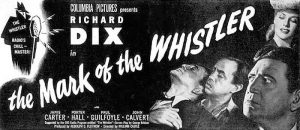
The Whistler has an interesting backstory, and would take much too long to go into here to give it the justice it warrants. A few points of interest will suffice for this offering of the beloved mystery show, the first of which is the use of the narrator as more than just a host. From Jim Ramsburg’s Gold Time Radio entry on The Whistler: “Like The Shadow’s first personification a dozen years earlier, Inner Sanctum’s ghostly Raymond in 1941 and The Mysterious Traveler in 1943, The Whistler stood outside the stories he narrated. Unlike the others, he used a unique second-person, present tense technique as if to talk directly with the central character of his stories – often an innocent drawn into the plot by circumstances or an amateur driven to murder as a last resort.” A second point of interest has to do with the trademark whistling that opens each episode. From Radio Spirits‘ Blog Archive on The Whistler: “The program featured one of radio’s classic openings: a haunting 13-note theme created by Wilbur Hatch (who also composed the show’s eerie mood music). Hatch estimated that only one person in twenty could whistle this exact melody, and for the show’s thirteen-year duration one person pretty much did—a young woman named Dorothy Roberts. In fact, during the war years, Roberts had to get permission from Lockheed (where she worked) to leave her factory job in order to make it to the program and whistle every week.”
The radio show proved popular enough that Columbia Pictures made eight Whistler films from 1944-48, all but one starring Richard Dix: The Whistler (1944), The Mark of the Whistler (1944), The Power of the Whistler (1945), The Voice of the Whistler (1945), Mysterious Intruder (1946), The Secret of the Whistler (1946), The Thirteenth Hour (1947) and The Return of the Whistler (1948). The show was brought to early television in 1954-55, but never caught on. Nevertheless (and due in great measure to roughly 500 of the estimated 700+ original shows still surviving–and the movies still showing up on classic movie tv channels), The Whistler probably enjoys a larger audience today than it did in its heyday during the Golden Age of Radio.
“The Other Woman” is a morality tale of sorts. It is an old story, told in countless ways and endless variation down through the ages in every medium imaginable, and though tragic it never seems to grow old or lose its sordid fascination. So listen now to this desperate woman who discovers her husband is having an affair and is filing for a divorce. Seem too mundane and quotidian for you? Think you know all the answers and how the domestic drama will turn out? Think again, dear friend, for this emotionally wrought play isn’t as cut and dried as it might appear, as paranoia and jealousy can cloud the mind and make it very difficult for a woman scorned to uncover “The Other Woman.”
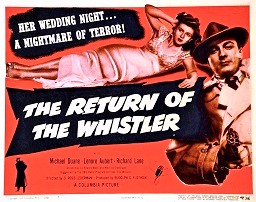
Play Time:29:30
{Last week’s Box 13 episode aired on Sunday, November 21, 1948—four days before Thanksgiving. By purest coincidence, this week’s The Whistler episode aired on Sunday, November 22, 1942—four days before Thanksgiving, albeit when the neighborhood gang was six years younger and to the boy a good bit shorter. Good habits die hard, it would seem, especially when it comes to finding the neighborhood gang at the corner newsstand, no matter the year. The day after giving “The Other Woman” a listen, they found themselves at their usual haunt deciding on which magazines to spend their nickels and dimes. Astounding SF (1930 to present, now Analog), as has often been noted here, was always a favorite when it came to SF magazines, especially since the relatively new firebrand editor John W. Campbell, Jr. was the editor and was making a habit of showcasing brilliant new talent within the magazine’s pages (a few of which appearing in 1942 included Fredric Brown, Isaac Asimov, Alfred Bester, A. E. Van Vogt, and Lester Del Rey). Astounding was a monthly in 1942. Another coincidence between my selection of last week’s pulp magazine covers and this one deals with who was featured on them. Dime Mystery (1932-1950), after running standard material for less than a dozen issues, altered its format to one of “weird menace.” Notice the name in the lower left corner of the issue below: Fredric Brown. Six years later would find his name on two of the magazines we featured last week—Detective Tales (Nov. 1948) and Black Mask (Nov. 1948). So not only did last week’s episode and this one air exactly 4 days before Thanksgiving, but the same author appeared on no fewer than 3 different magazine covers separated by the 6 year interval noted above. Dime Mystery was a bi-monthly in 1942. One of the longest running detective pulps was Thrilling Detective (1931-1953). It ran for a whopping 213 issues before succumbing to the pulp magazine crash of the early 1950s. It was a monthly in 1942.]
[Left: Astounding SF, Nov. 1942 – Center: Dime Mystery, Nov. 1942 – Right: Thrilling Detective, Nov. 1942]

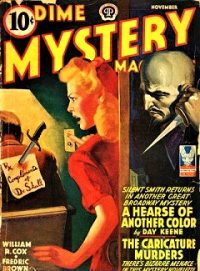
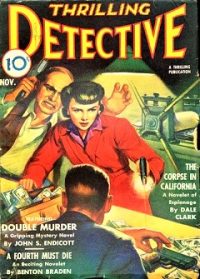
To view the entire list of Old Time Radio episodes go here.
